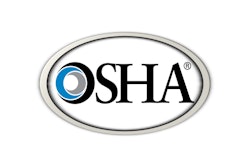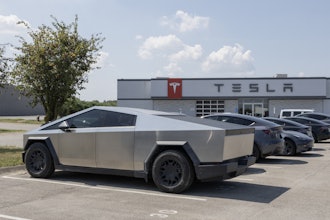Employee safety has always been a primary concern for the managers of industrial plants and warehouses. And while more plant operations have become automated and use robotics to increase efficiency, they have also created new safety challenges that must be addressed.
Regulatory bodies like EN ISO, RIA (Robotics Industry Association) and others have overhauled and revised their guidelines and requirements in the last decade to keep up with these technological advancements, but there are still some regulatory gaps. For example, automated stretch-wrapping operations are being widely used without any specific application-based safety regulations surrounding them.
A brief overview of the new industrial safety regulations and best practices is in order.
Automated/Robotic Processes at the Loading Dock
Simple stretch wrap machines have become as ubiquitous to loading dock areas as dock levelers, seals or shelters. As with most all other industrial processes, what began as a manual operation (the arduous task of bending, pulling and moving stretch wrap around a pallet) is now commonly automated. Most dock employees are happy about this.
However, this particular aspect of plant operation has long been overlooked as a hazard. As more and more facilities automate the palletizing and stretch wrapping process, it becomes increasingly important to protect employees and pedestrians from coming into contact with the moving parts of those machines. With these suppliers adding other automated functions to their floors (such as intelligent conveyors, AGVs and AS/RS systems), it’s critical that the safety methodology is similar to that of other robotic cells and is compliant with current standards.
There are no OSHA guidelines specific to the simple basic stretch wrap machines currently being used, other than the OSHA B1910 standards. As a rule of thumb, companies want to ensure safety of their employees and OSHA General Duties Clause stipulates the following:
(a) Each employer:
(1) Shall furnish to each of his employees employment a place of employment which is free from recognized hazards that are causing or are likely to cause death or serious physical harm to his employees; and…
(2) Shall comply with occupational safety and health standards promulgated under this Act.
(b) Each employee shall comply with occupational safety and health standards and all rules, regulations, and orders issued pursuant to this Act, which are applicable to his own actions and conduct.
Further, to make certain stretch wrapping equipment is safe, it really should be guarded or contained per 29 CFR 1910.212(a)(3)(ii), General Requirements of All Machines. That rule states, “The point of operation of machines, whose operation exposes an employee to injury, shall be guarded. The guarding device shall be in conformity with any appropriate standards therefore, or, in the absence of applicable specific standards, shall be so designed and constructed as to prevent the operator from having any part of his body in the danger zone during the operating cycle.” Many times these safeguards are either grossly inadequate or completely ignored, removed and not even considered.
Robotics in Stretch Wrap Processes
Stretch wrapping operations in warehouses and manufacturing facilities tend to be standalone processes and the trend toward automation of them is well established. More and more suppliers (OEMs) are incorporating robots into the wrapping process, allowing the robots to do the heavy work of handling the items to be palletized.
Additionally, intelligent conveyors, AGVs; and in some cases AS/RS systems; are responsible for the movement of the pallets to and from the pallet wrapping machines. These process suppliers (integrators and OEMs) must ensure that the palletizers can communicate with AGVs and conveyor systems and the robotic processes being performed, tying the control systems and safety requirements into the process.
Clearly, safety methodologies similar to those used with other robotic applications need to be devised and implemented at this point. This safety methodology needs to be compliant with the latest standards, referencing the new RIA and EN ISO standards, while adopting a more sophisticated approach employing those technologies. From the standpoint of the operation, the approach should not deter efficiency.
RIA 15.06-2013 Harmonizes International and U.S. Standards
Only a few years in practice, RIA R15.06 references ISO 10218-1 & 2, which addresses robots, robot systems and integration. This standard was written to be compliant with international standards already in place in Europe, making life easier for manufacturers and end users.
One of the main takeaways from this rule has been the requirement to identify hazards related to robot motion and the specific task being performed. Additionally, it requires validation and verification of the safety systems employed, and of the designs that incorporate protective measures for the robot cell and the operator. Because every robot system is different, requiring risk assessments is an important step in protecting employees.
Thanks to technological advances in safety controls, these types of applications can now safely be implemented. In the past, engineers designing these systems guarded for the maximum space, speed, and load of the machine. With these changes, the physical footprint of new stretch-wrapping cells can shrink. Coupled with the proper point-of-interaction safety devices such as automated high-speed barrier doors, significant floor space savings can be realized.
Point-of-Interaction Safety Options
Certainly, presence-sensing devices such as light curtains and laser scanners are potential solutions for point-of-interaction safety. However, automated barrier doors may provide an even better option, as they have many of the same benefits as presence sensors, but with several additional advantages. Most notably, automated barrier doors provide a physical barrier that can protect an employee and contain the process while at the same time restricting access to dangerous machine movement. This is particularly important for processes such as stretch wrapping in which inertia keeps machinery in motion even after it has shut down. Additionally, automated barrier doors can be located closer to the process, allowing for a much smaller footprint in the facility.
The most advanced roll-up automated barrier doors offer high-speed, high-cycle technology, as well as PLe hold-down mechanisms and safety rated non-contact interlock switches and controls. Most automated doors function from the top down, but some have been designed to operate from the ground up. This allows machine operators to easily interact with the process utilizing overhead cranes to load and unload large, heavy parts. They are also a great option for interaction points that have a very limited space.
Protect Employees While Remaining Efficient
As new technology is adopted to increase efficiency, it’s important for facility managers to simultaneously keep up with safety. If they don’t, regulations like RIA R15.06 and others are going to keep evolving to mandate safety. Before specifying or implementing new safety devices for new automated operations, be sure to perform a proper risk assessment and find the best solution for today’s and tomorrow’s processes.
Given the recent advances in their design and technology, automated barrier doors can be an excellent option to guard new automated robots and machines while protecting operators. This can ultimately increase productivity and the level of safety for years to come.
John Ritter is Rite-Hite Doors Product Manager.























